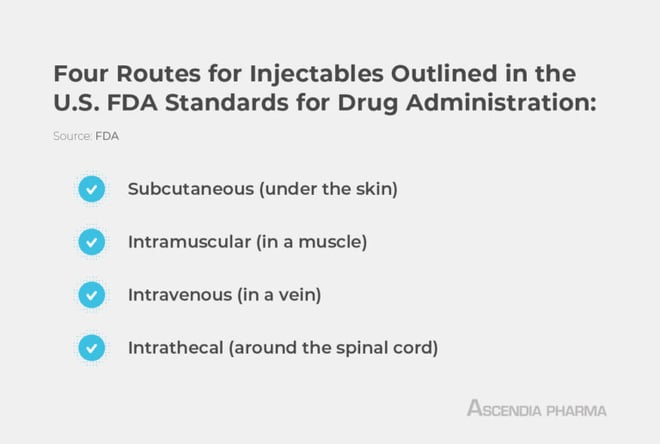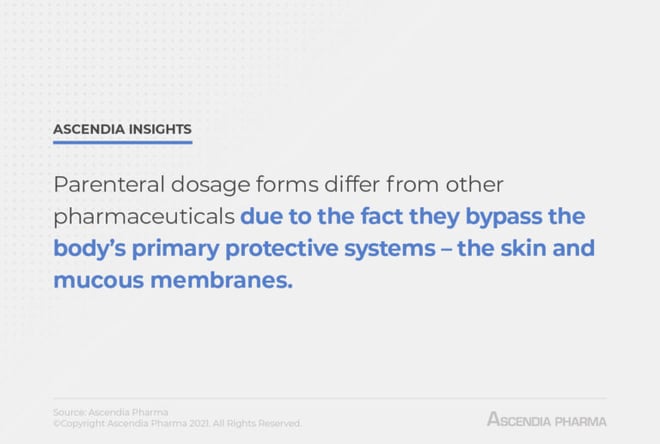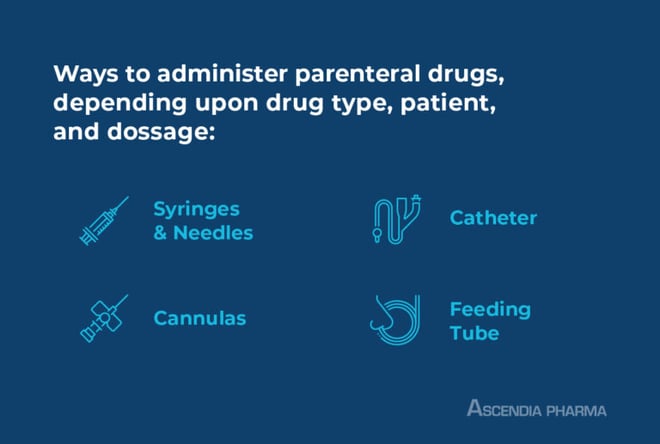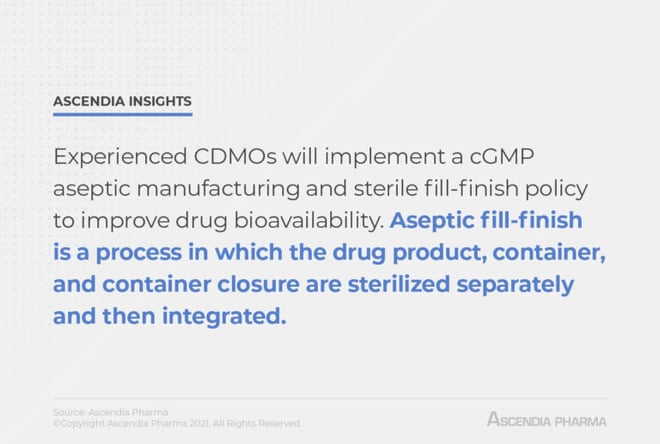Parenteral Formulation Development
Parenteral formulation development for drugs delivered by injection or infusion is the fastest and the second most common route of drug administration. These formulations must achieve good compatibility of the drug substances with the excipients and the primary container.
Successful formulation development can determine drug patentability, lifecycle, and overall market success. With growing pressure to take potential drug candidates from discovery to first-in-man clinical trials on schedule, more pharmaceutical and biotech companies are outsourcing these projects to a contract development and manufacturing organization (CDMO). The best CDMO partner must have expertise in overcoming the challenges associated with parenteral drug development, including:
- Low or no drug solubility in aqueous environments
- Low bioavailability in animal studies
- Incompatibility with desired delivery system
- Stability
The path to delivering stable drug formulations is multi-faceted. A constant focus on key control measures through pre-formulation development to commercialization is required to meet time-to-market schedules within the prescribed budget.
Formulation Development of Parenteral Products

Parenteral routes of administration are included in the U.S. Federal Drug Administration (FDA) standards for drug administration. The standards outline the four routes for injectables:
Subcutaneous (under the skin) – A subcutaneous drug injection establishes a deposit so the medication is released gradually into the patient’s circulation. The drug’s formulation will influence the period over which it is released. Absorption from this route is fairly rapid from aqueous solutions, but slow and sustained with repository preparations.
Drug Examples: Insulin and certain hormone medications.
Intramuscular (in a muscle) – Medication is deposited deep into the muscle mass, past the dermis and subcutaneous tissue, using the intramuscular route. Injecting the drug into the deepest muscle layers and into the rich blood supply results in rapid and complete absorption.
Drug Examples: Antibiotics (penicillin), biologicals (vaccines), and hormonal agents (testosterone).
Intravenous (in a vein) – The most common parenteral route is intravenous (IV), as it is the best way to deliver a dose rapidly and accurately. With an IV, the drug enters directly into systemic circulation without the delay associated with absorption processes for a faster therapeutic effect.
Drug Examples: Antibiotics, chemotherapy, and drugs for low blood pressure.
Intrathecal (around the spinal cord) – This route administers a drug within the vertebral column to bypass the blood-brain barrier.
Drug Examples: Currently, only three medications are approved by the FDA for use via the intrathecal route – morphine, ziconotide, and baclofen. Anesthesia is also administered via the intrathecal route.
ph of Parenteral Products
One critical aspect of parenteral formulation is the pH level. Drug formulations should have a target pH as close as possible to physiological pH. The acceptable range is pH 2–11 for IV and intramuscular injections, and pH 4-9 for subcutaneous injection due to potential irritation issues.
A buffer, such as acetate, phosphate, citrate, histidine, and TRIS, can help achieve an ideal range of pH 5-8. Buffer capacity should be minimized so body fluid can adjust to the formulation pH quickly to prevent irritation at the injection site.
For IV infusion, the solution pH is typically controlled by the salt form of the drug or by acids and bases without buffer due to in vivo tolerability considerations. In some cases, a compromise between solubility and stability of the drug substance may be required to find a target formulation pH in which drug loading and product stability are acceptable.
Large volume preparations of greater than 100 should not contain a pH buffer. The blood has a property that acts like a buffer and may compete with the injected drug product if the buffer is added in these cases.
Types of Parenteral Preparation

Parenteral preparations differ from other pharmaceuticals. This is due to the fact they bypass the body’s primary protective systems – the skin and mucous membranes. Parenteral dosages have many advantages, such as routes of administration, elimination of first pass effect, and better absorption. Four dosage forms are used with injectables:
Solutions – Most injectables are solutions. Typically, aqueous, they can be water mixed with glycols, alcohol, or other nonaqueous solvents.
Suspensions – A difficult parenteral preparation to formulate is a suspension. A delicate balance of variables is necessary to formulate a product that is easily resuspended and can be ejected through an 18- to 21-gauge needle through its shelf life.
Emulsions – Inherently unstable, an emulsion is a dispersion of one immiscible liquid in another. Formulation options are restricted, as there is a limited number of stabilizers and emulsifiers that can be used. Unwanted physiological effects limit the use of IV emulsions.
Dry powders – Many drugs are too unstable in an aqueous medium to allow formulation as a solution, suspension, or emulsion. In these cases, the drug is formulated as a dry powder that is reconstituted by adding water before administration.
Advantages of Parenteral Preparation
Parenteral drug development is expected to experience steady growth over the next decade. Main reasons are the advantages injectables provide in drug delivery and treatment of certain conditions.
- Fast-acting – A major benefit of parenteral administration is it can provide a rapid onset of action and rapid absorption of the drug.
- Absorption – Parenteral routes are better for drugs with poor absorption in the gastrointestinal tract (GIT), are not orally effective, or destroyed by digestive secretions.
- Accuracy – Injectables provide precise dosages, compared to other routes.
- Smaller Doses – A lower drug dosage is typically required, compared to solid/liquid oral dosage forms.
- Bioavailability – The active moiety enters systemic circulation faster and more predictably.
- Wider Patient Audience – Injectables can be used on patients who are unconscious or uncooperative.
- Taste & Smell – There is no issue with injectables having an unpleasant taste or smell because of its delivery method.
Disadvantages of Parenteral Preparation
Disadvantages of parenteral preparation include:
- Irreversible – Drugs administered via injectables cannot be reversed.
- Invasive – Because the route of drug administration can be intrusive, there is the potential for pain, tissue damage, or infections.
- Sterile – All parenteral dosages must be prepared in a sterile environment.
- Rapid Onset Only – Injectables cannot be used for sustained, prolonged, and extended-release of a drug.
- Cost – Formulation, manufacture, and packaging of parenteral preparations are more expensive than other routes.
Equipment Used in Parenteral Preparation
 Parenteral devices must be sterile, pyrogen-free and have no particulate matter. There are a few options to administer parenteral drugs, depending upon drug type, patient, and dosage.
Parenteral devices must be sterile, pyrogen-free and have no particulate matter. There are a few options to administer parenteral drugs, depending upon drug type, patient, and dosage.
Syringes & Needles – These sterile devices inject solutions into the body. The syringe is a calibrated glass or plastic cylinder with a plunger at one end and an opening to which the needle attaches. Syringe sizes vary from 0.25 ml to 450 ml and can be made from glass or assorted plastics.
Cannulas – A cannula is a thin tube that is inserted into the body cavity, such as the nose, or a vein. In addition to administering medication, cannulas are used to drain fluid or provide oxygen. There are 11 cannula types to meet designated conditions.
Catheter – For parenteral nutrition, a dedicated tube called a central venous catheter is placed in a main vein. The catheter tip is inserted near the heart.
Feeding tube – A medical device usually made of polyurethane or silicone used to provide nutrition to patients unable to swallow. Placement may be temporary to treat acute conditions or lifelong in the case of chronic disabilities.
Manufacturing of Parenteral Preparations
The parenteral preparation manufacturing process is complex and entails a series of steps from formulation development to first-in-man studies (table 1). The fast-acting nature of parenteral administration routes means that associated drug formulations must meet stricter compliance regulations to ensure patient safety. They must adhere to specific parameters to obtain approval from regulatory bodies. The result is that CDMOs must establish and adhere to a comprehensive approach, and be expert in sterile containment, fill/finish and data-driven manufacturing and control processes.
| Compounding | Closing |
|---|---|
| Mixing | Sealing |
| Filtration | Sorting |
| Filling | Inspection |
| Terminal sterilization | Labeling |
| Lyophilization | Final packaging |
Table 1: Parenteral drug manufacturing process

Experienced CDMOs will implement a cGMP aseptic manufacturing and sterile fill-finish policy to improve drug bioavailability. Aseptic fill-finish is a process in which the drug product, container, and container closure are sterilized separately and then integrated. Combining the drug, container, and closure in a clean room using special equipment that is self-contained in a sterile environment meets FDA guidelines related to cGMP.
Manufacturing must also consider parenteral injection types. Disposable/single-use-system injectable technologies provide alternatives to traditional compounding-filling in stainless steel or glass-lined vessels. The capabilities for single-use compounding-filling suites need to handle oxidation-prone compounds that are not compatible with traditional stainless-steel mixing vessels and transfer lines.
Ascendia manufactures sterile, injectable clinical trial materials in its Class 100 (ISO 5) clean room, and can also conduct aseptic processing.
Using isolator systems, Ascendia is able to minimize personnel involvement and separate the external cleanroom environment from the aseptic processing line. Ascendia also specializes in the production of sterile, dispersible dosage forms, including suspensions, nano-particles and nano-emulsions.
Injectable Formulation Development and Manufacturing
Ascendia Pharma has a proven track record in developing drug formulations for injectables. Implementing its BEST (Brilliant technology, Excellent service, Superior quality, and Trust) philosophy, the Ascendia team utilizes its proprietary nanotechnologies, cGMP manufacturing, and experienced scientists to meet your most difficult parenteral drug formulation challenges. Contact us today to see how we can become your Partner of Choice.
Want to learn more about
Ascendia's expertise?
Get up-to-date information

